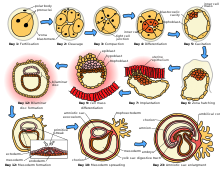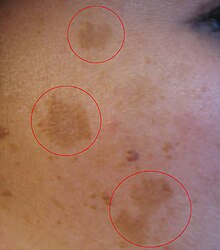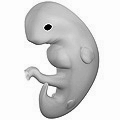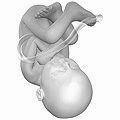Pregnancy
| Pregnancy | |
|---|---|
| Classification and external resources | |
 A pregnant woman in the third trimester. | |
| ICD-10 | Z33. |
| ICD-9 | 650 |
| DiseasesDB | 10545 |
| MedlinePlus | 002398 |
| eMedicine | article/259724 |
| MeSH | D011247 |
Contents[hide] |
Terminology
One scientific term for the state of pregnancy is gravid, and a pregnant female is sometimes referred to as a gravida.[1] Neither word is used in common speech. Similarly, the term "parity" (abbreviated as "para") is used for the number of previous successful live births. Medically, a woman who has never been pregnant is referred to as a "nulligravida", a woman who is (or has been only) pregnant for the first time as a "primigravida",[2] and a woman in subsequent pregnancies as a multigravida or "multiparous".[1][3][4] Hence, during a second pregnancy a woman would be described as "gravida 2, para 1" and upon live delivery as "gravida 2, para 2". An in-progress pregnancy, as well as abortions, miscarriages, or stillbirths account for parity values being less than the gravida number, whereas a multiple birth will increase the parity value. Women who have never carried a pregnancy achieving more than 20 weeks of gestation age are referred to as "nulliparous".[5]The term embryo is used to describe the developing offspring during the first 8 weeks following conception, and the term fetus is used from about 2 months of development until birth.[6][7]
In many societies' medical or legal definitions, human pregnancy is somewhat arbitrarily divided into three trimester periods, as a means to simplify reference to the different stages of prenatal development. The first trimester carries the highest risk of miscarriage (natural death of embryo or fetus). During the second trimester, the development of the fetus can be more easily monitored and diagnosed. The beginning of the third trimester often approximates the point of viability, or the ability of the fetus to survive, with or without medical help, outside of the uterus.[8]
Progression

Stages in prenatal development, with weeks and months numbered from last menstrual period.
Initiation

The initial stages of human embryogenesis.
The process of fertilization occurs in more than a single step, and the interruption of any of these can lead to a failure. Therefore, what is commonly known as "conception" is much more than the fusion between the female gamete and male spermatozoon. Through fertilization, the egg and sperm are saved: the egg is activated to begin its developmental program, and the haploid nuclei of the two gametes come together to form the genome of a new diploid organism [9]
At the very beginning of the process, the sperm undergoes a series of changes which makes pregnancy likely to occur. As freshly ejaculated sperm is unable or poorly able to fertilize,[10] the sperm undergoes the phenomenon called capacitation. It is estimated that during the ejaculation, 300,000,000 sperm are released, from which only 200 reach the oviduct. Capacitation is the process through which the spermatozoon is prepared for the merging with the egg. Capacitation occurs in 5 to 6 hours and it takes place once the sperm reaches the vagina. This is also the process through which the spermatozoon becomes hyperactivated and prepared for the acrosome reaction. In order to be able to fecundate the egg, the sperm must get through the coat surrounding the egg, the so called "zona pellucida". Once the zona pellucida is penetrated, the sperm is able to reach the oocyte. However in order to get through the egg's coat, the sperm undergoes an acrosome reaction that provides it with an enzymatic drill which is able to penetrate the zona pellucida. The acrosome itself is a modified lysosome, situated on the anterior part of the head of the sperm.
Once a sperm penetrates the zona pellucida, it binds to and fuses with the plasma membrane of the oocyte. Binding occurs at the posterior (post-acrosomal) region of the sperm head.[10] After binding occurs, the egg must also undergo a series of metabolic and physical changes which may influence the further development of the zygote. These changes are called in medicine egg activation, mainly because prior to fertilization, the egg is in a latent state.
Methods to assist reproduction also include intracytoplasmic sperm injection, gamete intrafallopian transfer (GIFT), zygote intrafallopian transfer (ZIFT), and embryo cryopreservation (frozen fertilized egg and sperm). These techniques are considered as alternatives to get pregnant by women who have tried unsuccessfully for at least one year. It is estimated that in the United States, more than 6 million adults, or 10% of the adult population, are affected by infertility.[11]
Prenatal period
Prenatal defines the period occurring "around the time of birth", specifically from 22 completed weeks (154 days) of gestation (the time when birth weight is normally 500 g) to 7 completed days after birth.[12]Legal regulations in different countries include gestation age beginning from 16 to 22 weeks (5 months) before birth.
Postnatal period
Main article: Postnatal
The postnatal period begins immediately after the birth of a child and then extends for about six weeks. During this period, the mother's body returns to prepregnancy conditions as far as uterus size and hormone levels are concerned.Perinatal period
The perinatal period is immediately before to after birth. Depending on the definition, it starts between the 20th to 28th week of gestation and ends between 1 to 4 weeks after birth (the word "perinatal" is a hybrid of the Greek "peri-" meaning 'around or about' and "natal" from the Latin "natus" meaning "birth.").Duration
The expected date of delivery (EDD) is 40 weeks counting from the first day of the last menstrual period (LMP), and birth usually occurs between 37 and 42 weeks.[13] The actual pregnancy duration is typically 38 weeks after conception. Though pregnancy begins at conception, it is more convenient to date from the first day of a woman's last menstrual period, or from the date of conception if known. Starting from one of these dates, the expected date of delivery can be calculated using the Naegele's rule for estimating date of delivery. A more accurate and sophisticated algorithm takes into account other variables, such as whether this is the first or subsequent child (i.e., pregnant woman is a primip or a multip, respectively), ethnicity, parental age, length of menstrual cycle, and menstrual regularity.Pregnancy is considered "at term" when gestation attains 37 complete weeks but is less than 42 (between 259 and 294 days since LMP). Events before completion of 37 weeks (259 days) are considered preterm; from week 42 (294 days) events are considered postterm.[14] When a pregnancy exceeds 42 weeks (294 days), the risk of complications for both the woman and the fetus increases significantly.[13][15] As such, obstetricians usually prefer to induce labour, in an uncomplicated pregnancy, at some stage between 41 and 42 weeks.[16][17]
Recent medical literature prefers the terminology preterm and postterm to premature and postmature. preterm and postterm are unambiguously defined as above, whereas premature and postmature have historical meaning and relate more to the infant's size and state of development rather than to the stage of pregnancy.[18][19]
Fewer than 5% of births occur on the due date; 50% of births are within a week of the due date, and almost 90% within 2 weeks.[unreliable medical source?][20] It is much more useful and accurate, therefore, to consider a range of due dates, rather than one specific day, with some online due date calculators providing this information.
Accurate dating of pregnancy is important, because it is used in calculating the results of various prenatal tests (for example, in the triple test). A decision may be made to induce labour if a fetus is perceived to be overdue. Furthermore, if LMP and ultrasound dating predict different respective due dates, with the latter being later, this might signify slowed fetal growth and therefore require closer review.
The age of viability has been receding because of continued medical progress. Whereas it used to be 28 weeks, it has been brought back to as early as 23, or even 22 weeks in some countries.
Childbirth
Main article: Childbirth
Childbirth is the process whereby an infant is born. It is considered by many[who?] to be the beginning of the infant's life, and age is defined relative to this event in most cultures.A woman is considered to be in labour when she begins experiencing regular uterine contractions, accompanied by changes of her cervix — primarily effacement and dilation. While childbirth is widely experienced as painful, some women do report painless labours, while others find that concentrating on the birth helps to quicken labour and lessen the sensations. Most births are successful vaginal births, but sometimes complications arise and a woman may undergo a cesarean section.
During the time immediately after birth, both the mother and the baby are hormonally cued to bond, the mother through the release of oxytocin, a hormone also released during breastfeeding.
Diagnosis
Further information: Obstetrics

Linea nigra in a woman at 22 weeks pregnant.
Most pregnant women experience a number of symptoms,[22] which can signify pregnancy. The symptoms can include nausea and vomiting, excessive tiredness and fatigue, cravings for certain foods that are not normally sought out, and frequent urination particularly during the night.
A number of early medical signs are associated with pregnancy.[23][24] These signs typically appear, if at all, within the first few weeks after conception. Although not all of these signs are universally present, nor are all of them diagnostic by themselves, taken together they make a presumptive diagnosis of pregnancy. These signs include the presence of human chorionic gonadotropin (hCG) in the blood and urine, missed menstrual period, implantation bleeding that occurs at implantation of the embryo in the uterus during the third or fourth week after last menstrual period, increased basal body temperature sustained for over 2 weeks after ovulation, Chadwick's sign (darkening of the cervix, vagina, and vulva), Goodell's sign (softening of the vaginal portion of the cervix), Hegar's sign (softening of the uterus isthmus), and pigmentation of linea alba – Linea nigra, (darkening of the skin in a midline of the abdomen, caused by hyperpigmentation resulting from hormonal changes, usually appearing around the middle of pregnancy).[23][24]
Pregnancy detection can be accomplished using one or more various pregnancy[21] tests, which detect hormones generated by the newly formed placenta. Clinical blood and urine tests can detect pregnancy 12 days after implantation.[25] Blood pregnancy tests are more accurate than urine tests.[26] Home pregnancy tests are urine tests, and normally cannot detect a pregnancy until at least 12 to 15 days after fertilization. A quantitative blood test can determine approximately the date the embryo was conceived.
In the post-implantation phase, the blastocyst secretes a hormone named human chorionic gonadotropin, which in turn stimulates the corpus luteum in the woman's ovary to continue producing progesterone. This acts to maintain the lining of the uterus so that the embryo will continue to be nourished. The glands in the lining of the uterus will swell in response to the blastocyst, and capillaries will be stimulated to grow in that region. This allows the blastocyst to receive vital nutrients from the woman.
Despite all the signs, some women may not realize they are pregnant until they are quite far along in their pregnancy. In some cases, a few women have not been aware of their pregnancy until they begin labour. This can be caused by many factors, including irregular periods (quite common in teenagers), certain medications (not related to conceiving children), and obese women who disregard their weight gain. Others may be in denial of their situation.
An early sonograph can determine the age of the pregnancy fairly accurately. In practice, doctors typically express the age of a pregnancy (i.e., an "age" for an embryo) in terms of "menstrual date" based on the first day of a woman's last menstrual period, as the woman reports it. Unless a woman's recent sexual activity has been limited, she has been charting her cycles, or the conception is the result of some types of fertility treatment (such as IUI or IVF), the exact date of fertilization is unknown. Without symptoms such as morning sickness, often the only visible sign of a pregnancy is an interruption of the woman's normal monthly menstruation cycle, (i.e., a "late period"). Hence, the "menstrual date" is simply a common educated estimate for the age of a fetus, which is an average of 2 weeks later than the first day of the woman's last menstrual period. The term "conception date" may sometimes be used when that date is more certain, though even medical professionals can be imprecise with their use of the two distinct terms. The due date can be calculated by using Naegele's rule. The expected date of delivery may also be calculated from sonogram measurement of the fetus. This method is slightly more accurate than methods based on LMP.[27]
Diagnostic criteria are: Women who have menstrual cycles and are sexually active, a period delayed by a few days or weeks is suggestive of pregnancy; elevated B-hcG to around 100,000 mIU/mL by 10 weeks of gestation.[2]
Physiology
Pregnancy is typically broken into three periods, or trimesters, each of about three months. While there are no hard and fast rules, these distinctions are useful in describing the changes that take place over time.First trimester
Traditionally, doctors have measured pregnancy from a number of convenient points, including the day of last menstruation, ovulation, fertilization, implantation and chemical detection. In medicine, pregnancy is often defined as beginning when the developing embryo becomes implanted into the endometrial lining of a woman's uterus. In some cases where complications may have arisen, the fertilized egg might implant itself in the fallopian tubes, the cervix, the ovary or in the abdomen causing an ectopic pregnancy. In the case of an ectopic pregnancy there is no way for the pregnancy to progress normally. If left untreated, it can cause harm and possibly death for the mother when a rupture occurs. Sometimes it will go away on its own but otherwise a surgical procedure or medicine is given to remove the tubal pregnancy since there is no way of the pregnancy being able to continue safely.[28] Most pregnant women do not have any specific signs or symptoms of implantation, although it is not uncommon to experience minimal bleeding at implantation. Some women will also experience cramping during their first trimester. This is usually of no concern unless there is spotting or bleeding as well. After implantation the uterine endometrium is called the decidua. The placenta, which is formed partly from the decidua and partly from outer layers of the embryo, connects the developing fetus to the uterine wall to allow nutrient uptake, waste elimination, and gas exchange via the mother's blood supply. The umbilical cord is the connecting cord from the embryo or fetus to the placenta. The developing embryo undergoes tremendous growth and changes during the process of fetal development.Morning sickness occurs in about seventy percent of all pregnant women and typically improves after the first trimester.[29][dead link] Although described as "morning sickness", women can experience this nausea during afternoon, evening, and throughout the entire day.
In the first 12 weeks of pregnancy, the nipples and areolas darken due to a temporary increase in hormones.[30]
The first 12 weeks of pregnancy are considered to make up the first trimester. The first two weeks from the first trimester are calculated as the first two weeks of pregnancy even though the pregnancy does not actually exist. These two weeks are the two weeks before conception and include the woman's last period.
The third week is the week in which fertilization occurs and the 4th week is the period when implantation takes place. In the 4th week, the fecundated egg reaches the uterus and burrows into its wall which provides it with the nutrients it needs. At this point, the zygote becomes a blastocyst and the placenta starts to form. Moreover, most of the pregnancy tests may detect a pregnancy beginning with this week.
The 5th week marks the start of the embryonic period. This is when the baby's brain, spinal cord, heart and other organs begin to form.[31] At this point the embryo is made up of three layers, of which the top one (called the ectoderm) will give rise to the baby's outermost layer of skin, central and peripheral nervous systems, eyes, inner ear, and many connective tissues.[31] The heart and the beginning of the circulatory system as well as the bones, muscles and kidneys are made up from the mesoderm (the middle layer). The inner layer of the embryo will serve as the starting point for the development of the baby's lungs, intestine and bladder. This layer is referred to as the endoderm. A baby at 5 weeks is normally between 1⁄16 and 1⁄8 inch (1.6 and 3.2 mm) in length.
In the 6th week, the baby will be developing basic facial features and its arms and legs start to grow. At this point, the embryo is usually no longer than 1⁄6 to 1⁄4 inch (4.2 to 6.3 mm). In the following week, the brain, face and arms and legs quickly develop. In the 8th week, the baby starts moving and in the next 3 weeks, the baby's toes, neck and genitals develop as well. According to the American Pregnancy Association, by the end of the first trimester, the fetus will be about 3 inches (76 mm) long and will weigh approximately 1 ounce (28 g).[32]
Second trimester
Weeks 13 to 28 of the pregnancy are called the second trimester. Most women feel more energized in this period, and begin to put on weight as the symptoms of morning sickness subside and eventually fade away.In the 20th week, the uterus, the muscular organ that holds the developing fetus, can expand up to 20 times its normal size during pregnancy. Although the fetus begins to move and takes a recognizable human shape during the first trimester, it is not until the second trimester that movement of the fetus, often referred to as "quickening", can be felt. This typically happens in the fourth month, more specifically in the 20th to 21st week, or by the 19th week if the woman has been pregnant before. However, it is not uncommon for some women not to feel the fetus move until much later. The placenta fully functions at this time and the fetus makes insulin and urinates. The reproductive organs distinguish the fetus as male or female.
Third trimester
Final weight gain takes place, which is the most weight gain throughout the pregnancy. The fetus will be growing the most rapidly during this stage, gaining up to 28 g per day. The woman's belly will transform in shape as the belly drops due to the fetus turning in a downward position ready for birth. During the second trimester, the woman's belly would have been very upright, whereas in the third trimester it will drop down quite low, and the woman will be able to lift her belly up and down. The fetus begins to move regularly, and is felt by the woman. Fetal movement can become quite strong and be disruptive to the woman. The woman's navel will sometimes become convex, "popping" out, due to her expanding abdomen. This period of her pregnancy can be uncomfortable, causing symptoms like weak bladder control and backache. Movement of the fetus becomes stronger and more frequent and via improved brain, eye, and muscle function the fetus is prepared for ex utero viability. The woman can feel the fetus "rolling" and it may cause pain or discomfort when it is near the woman's ribs and spine.There is head engagement in the third trimester, that is, the fetal head descends into the pelvic cavity so that only a small part (or none) of it can be felt abdominally. The perenium and cervix are further flattened and the head may be felt vaginally.[33] Head engagement is known colloquially as the baby drop, and in natural medicine as the lightening because of the release of pressure on the upper abdomen and renewed ease in breathing. However, it severely reduces bladder capacity, increases pressure on the pelvic floor and the rectum, and the mother may experience the perpetual sensation that the fetus will "fall out" at any moment.[34]
It is during this time that a baby born prematurely may survive. The use of modern medical intensive care technology has greatly increased the probability of premature babies surviving, and has pushed back the boundary of viability to much earlier dates than would be possible without assistance.[35] In spite of these developments, premature birth remains a major threat to the fetus, and may result in ill health in later life, even if the baby survives.
Embryonic and fetal development
See also: Prenatal development
Prenatal development is divided into two primary biological stages. The first is the embryonic stage, which lasts for about two months. At this point, the fetal stage begins. At the beginning of the fetal stage, the risk of miscarriage decreases sharply,[36] all major structures including the head, brain, hands, feet, and other organs are present, and they continue to grow and develop. When the fetal stage commences, a fetus is typically about 30 mm (1.2 inches) in length, and the heart can be seen beating via sonograph; the fetus bends the head, and also makes general movements and startles that involve the whole body.[37] Some fingerprint formation occurs from the beginning of the fetal stage.[38]Electrical brain activity is first detected between the 5th and 6th week of gestation, though this is still considered primitive neural activity rather than the beginning of conscious thought, something that develops much later in fetation. Synapses begin forming at 17 weeks, and at about week 28 begin to multiply at a rapid pace which continues until 3–4 months after birth. It is not until week 23 that the fetus can survive, albeit with major medical support, outside of the womb, because it does not possess a sustainable human brain until that time.[39]
| Embryo at 4 weeks after fertilization[40] | Fetus at 8 weeks after fertilization[41] | Fetus at 18 weeks after fertilization[42] | Fetus at 38 weeks after fertilization[43] |
| 75-mm fetus (about 14 weeks gestational age) |
Physiological changes
Main article: Maternal physiological changes in pregnancy

Melasma pigment changes to the face due to pregnancy
Management
Main article: Prenatal care
Prenatal medical care is the medical and nursing care recommended for women before and during pregnancy. The aim of good prenatal care is to detect any potential problems early, to prevent them if possible (through recommendations on adequate nutrition, exercise, vitamin intake etc.), and to direct the woman to appropriate specialists, hospitals, etc. if necessary.Nutrition
Main article: Nutrition and pregnancy
A balanced, nutritious diet is an important aspect of a healthy pregnancy. Eating a healthy diet, balancing carbohydrates, fat, and proteins, and eating a variety of fruits and vegetables, usually ensures good nutrition. Those whose diets are affected by health issues, religious requirements, or ethical beliefs may choose to consult a health professional for specific advice.Adequate periconceptional folic acid (also called folate or Vitamin B9) intake has been proven to limit fetal neural tube defects, preventing spina bifida, a very serious birth defect. The neural tube develops during the first 28 days of pregnancy, explaining the necessity to guarantee adequate periconceptional folate intake.[48][49] Folates (from folia, leaf) are abundant in spinach (fresh, frozen, or canned), and are found in green leafy vegetables e.g. salads, beets, broccoli, asparagus, citrus fruits and melons, chickpeas (i.e. in the form of hummus or falafel), and eggs. In the United States and Canada, most wheat products (flour, noodles) are fortified with folic acid.[50]
DHA omega-3 is a major structural fatty acid in the brain and retina, and is naturally found in breast milk. It is important for the woman to consume adequate amounts of DHA during pregnancy and while nursing to support her well-being and the health of her infant. Developing infants cannot produce DHA efficiently, and must receive this vital nutrient from the woman through the placenta during pregnancy and in breast milk after birth.[51]
Several micronutrients are important for the health of the developing fetus, especially in areas of the world where insufficient nutrition is prevalent.[52] In developed areas, such as Western Europe and the United States, certain nutrients such as Vitamin D and calcium, required for bone development, may require supplementation.[53][54][55]
Dangerous bacteria or parasites may contaminate foods, particularly Listeria and toxoplasma, toxoplasmosis agent. Careful washing of fruits and raw vegetables may remove these pathogens, as may thoroughly cooking leftovers, meat, or processed meat. Soft cheeses may contain Listeria; if milk is raw, the risk may increase. Cat feces pose a particular risk of toxoplasmosis. Pregnant women are also more prone to Salmonella infections from eggs and poultry, which should be thoroughly cooked. Practicing good hygiene in the kitchen can reduce these risks.[56]
Weight gain
Caloric intake must be increased to ensure proper development of the fetus. The amount of weight gained during a single pregnancy varies among women. The Institute of Medicine recommends an overall pregnancy weight gain for women starting pregnancy at a normal weight, with a body mass index of 18.5-24.9, of 25-35 pounds (11.4-15.9 kg).[57] Women who are underweight, with a BMI of less than 18.5, may need to gain between 28-40 lbs. Overweight women are advised to gain between 15-25 lbs, whereas an obese woman may expect to gain between 11-20 lbs. Doctors and dietitians may make different, or more individualized, recommendations for specific patients, based on factors including low maternal age, nutritional status, fetal development, and morbid obesity.During pregnancy, insufficient or excessive weight gain can compromise the health of the mother and fetus. All women are encouraged to choose a healthy diet regardless of pre-pregnancy weight. Exercise during pregnancy, such as walking and swimming, is recommended for healthy pregnancies. Exercise has notable health benefits for both mother and baby, including preventing excessive weight gain.[58]
Immune tolerance
Main article: Immune tolerance in pregnancy
The fetus inside a pregnant woman may be viewed as an unusually successful allograft, since it genetically differs from the woman.[59] In the same way, many cases of spontaneous abortion may be described in the same way as maternal transplant rejection.[59]Medication use
Main article: Drugs in pregnancy
Drugs used during pregnancy can have temporary or permanent effects on the fetus. Therefore many physicians would prefer not to prescribe for pregnant women, the major concern being over teratogenicity of the drugs.Drugs have been classified into categories A,B,C,D and X based on the Food and Drug Administration (FDA) rating system to provide therapeutic guidance based on potential benefits and fetal risks. Drugs like multivitamins that have demonstrated no fetal risks after controlled studies in humans are classified as Category A. On the other hand drugs like thalidomide with proven fetal risks that outweigh all benefits are classified as Category X.[60]
Exposure to toxins
| This article needs references that appear in reliable third-party publications. Primary sources or sources affiliated with the subject are generally not sufficient for a Wikipedia article. Please add more appropriate citations from reliable sources. (December 2010) |
- Alcohol ingestion during pregnancy may cause fetal alcohol syndrome, a permanent and often devastating birth-defect syndrome. A number of studies have shown that light to moderate drinking during pregnancy might not pose a risk to the fetus, although no amount of alcohol during pregnancy can be guaranteed to be absolutely safe.[61][62][63]
- Numerous studies show that children exposed to prenatal cigarette smoke may experience a wide range of behavioral, neurological, and physical difficulties.[64]
- Elemental mercury and methylmercury are two forms of mercury that may pose risks in pregnancy. Methylmercury, a worldwide contaminant of seafood and freshwater fish, is known to produce adverse nervous system effects, especially during brain development.[65] Eating fish is the main source of mercury exposure in humans and some fish may contain enough mercury to harm an unborn baby's developing nervous system, sometimes leading to learning disabilities. Mercury is present in many types of fish, but it is mostly found in certain large fish. The United States Food and Drug Administration and the Environmental Protection Agency advise pregnant women not to eat swordfish, shark, king mackerel and tilefish and limit consumption of albacore tuna to 6 ounces or less a week.[66]
- The Center for Children's Environmental Health reports studies that demonstrate that exposure to air pollution during pregnancy is related to adverse birth outcomes including low birth weight, premature delivery, and heart malformations. Cord blood of exposed babies shows DNA damage that has been linked to cancer. Follow-up studies show a higher level of developmental delays at age three, lower scores on IQ tests and increased behavioral problems at ages six and eight.[67][68]
- According to the U.S. Centers for Disease Control, the developing nervous system of the fetus is particularly vulnerable to lead toxicity. Neurological toxicity is observed in children of exposed women as a result of the ability of lead to cross the placental barrier and to cause neurological impairment in the fetus. A special concern for pregnant women is that some of the bone lead accumulation is released into the blood during pregnancy. Several studies have provided evidence that even low maternal exposures to lead produce intellectual and behavioral deficits in children1.[69]
- A 2006 study found that children who were exposed prenatally to the insecticide chlorpyrifos had significantly poorer mental and motor development by three years of age and increased risk for behavior problems.[70] A 2007 study using a mouse model suggested that exposure to polycyclic aromatic hydrocarbons prior to conceiving and when lactating reduces the number of eggs in the ovaries of female offspring by two-thirds.[71] A 2009 study of pregnant women exposed to tetrachloroethylene in drinking water found an increased risk of oral clefts and neural tube defects in their children.[72] A 2009 study found that prenatal exposure to phthalates, the chemical compounds used as plasticizers in a wide variety of personal care products, children's toys, and medical devices, may be an environmental risk factor for low birth weight in infants." [73] A 2010 study found that prenatal exposure to flame retardant compounds called polybrominated diphenyl ethers is associated with adverse neurodevelopmental effects in young children.[74]
Sexual activity during pregnancy
Most pregnant women can enjoy sexual activity during pregnancy throughout gravidity. Most research suggests that, during pregnancy, both sexual desire and frequency of sexual relations decrease.[75][76] In context of this overall decrease in desire, some studies indicate a second-trimester increase, preceding a decrease.[77] However, these decreases are not universal: a significant number of women report greater sexual satisfaction throughout their pregnancies.[78]Abortion
Main article: Abortion
An abortion is the termination of the fetus, either naturally or via medical methods, normally within the first trimester. Natural abortion (miscarriage) is rare more than two months after fertilization.[36]Complications
| This section needs additional citations for verification. Please help improve this article by adding reliable references. Unsourced material may be challenged and removed. (December 2010) |
Main article: Complications of pregnancy
Each year, according to the WHO, ill-health as a result of pregnancy is experienced (sometimes permanently) by more than 20 million women around the world. Furthermore, the "lives of eight million women are threatened, and more than 500,000 women are estimated to have died in 1995 as a result of causes related to pregnancy and childbirth".[79]Pregnancy poses varying levels of health risk for women, depending on their medical profile before pregnancy.
The following are some of the complaints that may occur during and/or after pregnancy due to the many changes which pregnancy causes in a woman's body:
- Anemia[80]
- Back pain. A particularly common complaint in the third trimester when the patient's center of gravity has shifted.
- Carpal tunnel syndrome in between an estimated 21% to 62% of cases, possibly due to edema.[81]
- Constipation. A complaint that is caused by decreased bowel mobility secondary to elevated progesterone (normal in pregnancy), which can lead to greater absorption of water.
- Braxton Hicks contractions. Occasional, irregular, and often painless contractions that occur several times per day.
- Edema (swelling). Common complaint in advancing pregnancy. Caused by compression of the inferior vena cava (IVC) and pelvic veins by the uterus leads to increased hydrostatic pressure in lower extremities.
- Regurgitation, heartburn, and nausea. Common complaints that may be caused by Gastroesophageal Reflux Disease (GERD); this is determined by relaxation of the lower esophageal sphincter (LES) and increased transit time in the stomach (normal in pregnancy), as well as by increased intraabdominal pressure, caused by the enlarging uterus.
- Haemorrhoids. Complaint that is often noted in advancing pregnancy. Caused by increased venous stasis and IVC compression leading to congestion in venous system, along with increased abdominal pressure secondary to the pregnant space-occupying uterus and constipation.
- Pelvic girdle pain. PGP disorder is complex and multi-factorial and likely to be represented by a series of sub-groups with different underlying pain drivers from peripheral or central nervous system,[82] altered laxity/stiffness of muscles,[83] laxity to injury of tendinous/ligamentous structures[84] to ‘mal-adaptive’ body mechanics.[85] Musculo-Skeletal Mechanics involved in gait and weightbearing activities can be mild to grossly impaired. PGP can begin peri or postpartum. There is pain, instability or dysfunction in the symphysis pubis and/or sacroiliac joints.
- Postpartum depression
- Postpartum psychosis
- Round Ligament Pain. Pain experienced when the ligaments positioned under the uterus stretch and expand to support the woman's growing uterus
- Thromboembolic disorders. The leading cause of death in pregnant women in the USA.[86]
- Increased urinary frequency. A common complaint referred by the gravida, caused by increased intravascular volume, elevated GFR (glomerular filtration rate), and compression of the bladder by the expanding uterus.
- Urinary tract infection[87]
- Varicose veins. Common complaint caused by relaxation of the venous smooth muscle and increased intravascular pressure.
- PUPPP skin disease that develop around the 32nd week. (Pruritic Urticarial Papules and Plaques of Pregnancy), red plaques, papules, itchiness around the belly button that spread all over the body except for the inside of hands and face.












No comments:
Post a Comment